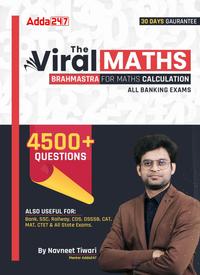Directions (1 – 5): Each of the following question is followed by two quantities i.e. Quantity I & Quantity II which you have to calculate and mark answer accordingly.

Q2. An article which costs Rs 500 was marked up by 20% above its cost price.
Quantity I: Discount percentage offered, when the article was sold at a price which gave a profit of Rs 50.
Quantity II: Profit Percentage, when two successive discounts each of 5% is offered.
(a) Quantity I>Quantity II
(b) Quantity I≥Quantity II
(c) Quantity I<Quantity II
(d) Quantity I≤Quantity II
(e) Quantity I=Quantity II or no relation
Q3. Average marks obtained by a candidate in 3 subjects (Physics, Chemistry, Maths) is 90.
Quantity I: The candidate scored 90 marks in Maths. Marks scored by him in Physics is equal to average of marks obtained by him in Maths & Chemistry, then how much marks he scored in Physics?
Quantity II: marks scored in Chemistry, when his marks in Physics are equal to average marks of all 3 subjects. Marks scored in Chemistry are 25% more than that of in Maths.
(a) Quantity I>Quantity II
(b) Quantity I≥Quantity II
(c) Quantity I<Quantity II
(d) Quantity I≤Quantity II
(e) Quantity I=Quantity II or no relation

Q5. Side of square is 3.5 cm more than radius of circle and Radius of circle is 50% more than breadth of rectangle whose length is 15 cm. Circumference of circle is 50% more than perimeter of rectangle.
Quantity I – What will be area of square. (In sq.cm.)
Quantity II – two times of area of rectangle. (In sq.cm.)
(a) Quantity I ≥ Quantity II
(b) Quantity I ≤ Quantity II
(c) Quantity I > Quantity II
(d) Quantity I = Quantity II or No relation
(e) Quantity I < Quantity II
Solutions





. . . . . .





 Quantitative Aptitude Quiz For Bank Main...
Quantitative Aptitude Quiz For Bank Main...
 Quantitative Aptitude Quiz For Bank Foun...
Quantitative Aptitude Quiz For Bank Foun...




